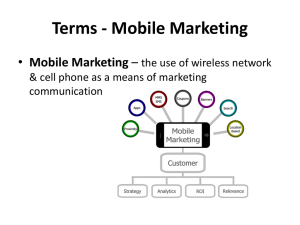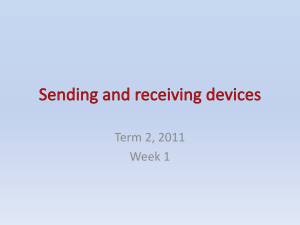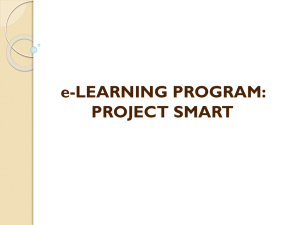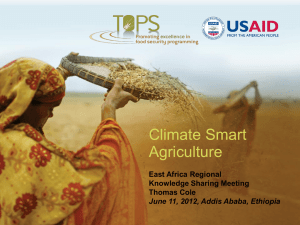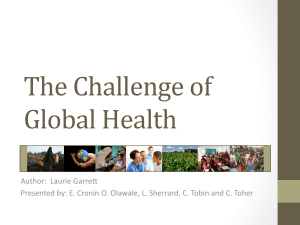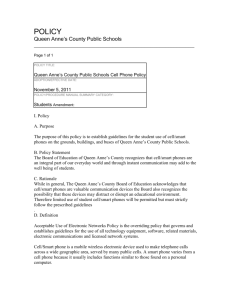Diversity in Smartphone Usage
advertisement
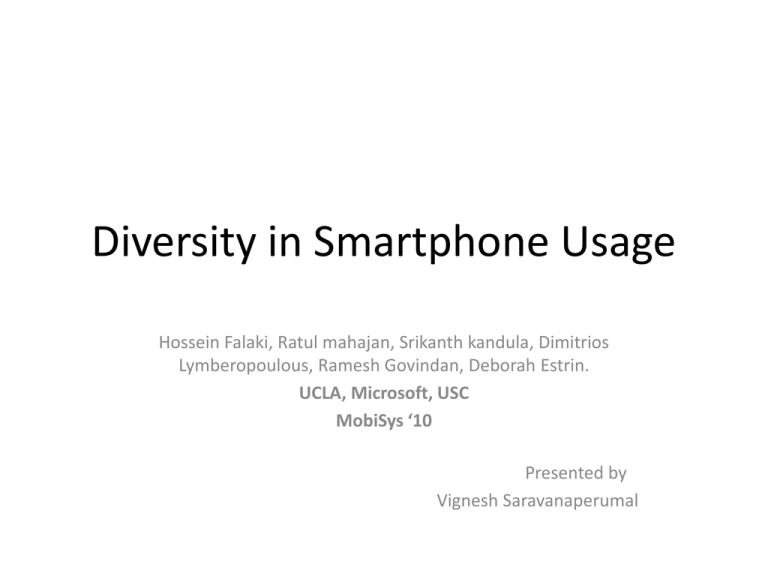
Diversity in Smartphone Usage Hossein Falaki, Ratul mahajan, Srikanth kandula, Dimitrios Lymberopoulous, Ramesh Govindan, Deborah Estrin. UCLA, Microsoft, USC MobiSys ‘10 Presented by Vignesh Saravanaperumal Smart phone - Intro Mobile phone Smart phone (Mobile phone + various Sensors ) What if your monitor could be plugged into your phone? What if you really didn't need a laptop, since your phone's CPU could power most applications, and draw data from the cloud? Nirvana Phones What does this Paper say? This paper, in short is kind of statistics paper which discusses about the various ways the users interact with the smart phones and its outcome Why did they do this paper? Basic Facts about Smartphone Usage Are Unknown 5 Why Do We Need to Know These Facts? How can we improve smart phone performance and usability? Everyone is Identical users different Can we improve resource management on smart phones through personalization? 6 Main Findings 1. Users are quantitatively very diverse in their usage 2. But invariants exist and can be harnessed 7 Smart phone Usage Comprehensive system view Diversity in interaction Interaction Application Interaction model Energy Diversity in application usage Application usage model Diversity in battery usage Energy drain model 8 Who participated in this survey? Platform # UsersInformation Demographics Duration Logged Android Android Android 33 WinMobile 222 WinMobile 16 high school students 7-21 Weeks/user Screen state workers 17 knowledge App usage Weeks/user 16 Social8-28 Communicators Battery level 56 Life Power Users Net traffic per app 59 Business Power Users Call starts and ends 37 Organizer Practicals Screen state Applications used 9 Users have disparate interaction levels Two orders 10 Sources of Interaction Diversity User Demographics Session count Session length 11 User Demographics Do Not Explain Diversity Interaction Time: Session Lengths Contribute to Diversity 13 Number of Sessions Contribute to Diversity 14 Session Length and Count Are Uncorrelated Interaction Sessions: Close Look at Interaction Sessions Exponential distribution Sessions terminated by screen timeout Few very long sessions Shifted Pareto distribution Most sessions are short 16 Modeling Interaction Sessions Extremely long sessions are being modeled well 17 Diurnal Patterns: Smart phone Usage Interaction Diversity in interaction Interaction model Application Diversity in application usage Application usage model Energy 19 Users Run Disparate Number of Applications 50% of users run more than 40 apps 20 Application Breakdown: Close Look at Application Popularity Straight line in semi-log plot appears for all users Different list for each user 22 Application Popularity Relationship to user demographic: What does this graph signifies? These graphs cannot reliably predict how a user will use the phone. While demographic information appears to help in some cases (for e.g., the variation in usage of productivity software in Dataset1), such cases are not the norm, and it is hard to guess when demographic information would be useful. Diurnal patterns: Time dependent application popularity was recently reported by Trestian based on an analysis of the network traffic logs from a 3G provider and this analysis confirms the effect. Application Sessions Applications run per interaction: 90%, of interactions include only one application Application session lengths: what interesting sight do these graphs reveal ? Smart phone Usage Interaction Diversity in interaction Interaction model Application Diversity in application usage Application usage model Energy Diversity in energy drain Predicting energy drain 27 Users Are Diverse in Energy Drain Two orders 28 Close Look at Energy Drain Significant variation across time High variation within each hour 29 Modeling Energy Drain 30 Network Traffic Traffic per day Interactive traffic Diurnal patterns The Network Analysis was carried out on Dataset 1 The traffic includes 3G radio and the 802.11 wireless link Network Traffic Traffic per day: • • • The traffic received - 1 to 1000 MB The traffic sent - 0.3 to 100 MB. The median values are 30 MB sent and 5 MB received Conclusions Users are quantitatively diverse in their usage • Building effective systems for all users is challenging • Static policies cannot work well for all users Invariants exist and can be harnessed • Users have similar distributions with different parameters. • This significantly facilitates the adaptation task 33 Questions Raised? Based upon these statistics what can be the solution to Resource management in Smart phones? Customization (Adaptation), but Is it possible? Analyzing the Qualitative similarities among users User behavior in the past must also predictive of the future
